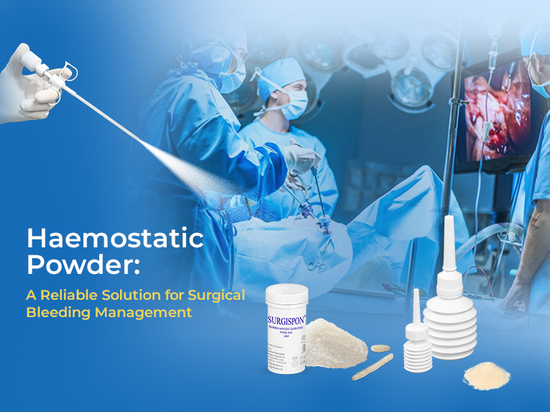
#Product Trends
Role of Oxidized Regenerated Cellulose Gauze in Managing Intraoperative Bleeding During Myomectomy
Surgi-ORC® in Myomectomy
Uterine fibroids are a common health condition affecting millions of women globally, often leading to symptoms such as heavy menstrual bleeding, pelvic pain, and infertility, which significantly diminish a woman’s quality of life [1]. For women who seek to preserve fertility or alleviate these distressing symptoms, myomectomy—the surgical removal of fibroids—is a preferred treatment. However, a critical challenge during myomectomy is the management of intraoperative bleeding, which can be life-threatening if uncontrolled [2].
Myomectomy is a specialized procedure designed to remove uterine fibroids, and it can be performed through various approaches, including laparotomy (open surgery), laparoscopy (minimally invasive surgery), or hysteroscopy. Studies indicate that blood loss in laparoscopic myomectomies can reach 100 ml, while open surgeries may experience double this amount [3]. Excessive bleeding not only complicates the surgery but can also delay recovery and increase the risk of postoperative complications, such as infection or the need for blood transfusions.
Oxidized regenerated cellulose gauze: A breakthrough in hemostasis
Oxidized regenerated cellulose gauze (Surgi-ORC® Original) is highly effective in managing excessive bleeding, a common complication in procedures like myomectomy. Designed to control capillary, venous, and small arterial bleeding, it is especially useful when conventional methods such as suturing or electrical coagulation are inadequate [6]. Made from oxidized regenerated cellulose, Surgi-ORC® promotes hemostasis by activating the body’s natural coagulation pathways. Upon contact with blood, it forms a gelatinous mass that acts as a matrix for platelet adherence, rapidly facilitating clot formation. Additionally, the low pH environment it creates induces vasoconstriction, further reducing bleeding, while also offering antimicrobial properties.
This dual mechanism—mechanical blockage of the bleeding site and promotion of natural clotting—makes Surgi-ORC® an invaluable tool in controlling bleeding during complex surgical procedures.
Case Study: Efficacy of Surgi-ORC®in Myomectomy
A recent case study evaluated the efficacy and safety of Surgi-ORC® (Surgi-ORC® Original/ORCG and Surgi-ORC® Non-Woven/SNOW variants) during a myomectomy in a 36-year-old female with uterine fibroids. During the surgery, the patient experienced mild bleeding, which was effectively managed using Surgi-ORC®. Hemostasis was achieved within an average of 1 minute and 6 seconds without the need for additional interventions, such as electrocoagulation or pharmacological agents.
Benefits of Surgi-ORC® in Myomectomy
Rapid Hemostasis: achieves hemostasis typically within 2 minutes, reducing the time required to control bleeding and allowing for smoother surgical flow.
Biocompatibility and Absorption: fully absorbed by the body within days, eliminating the need for surgical removal and minimizing the risk of foreign body reactions or infections.
Ease of Use: Surgi-ORC® is highly regarded for its easy handling, ability to conform to irregular surfaces, and precise cutability, seamlessly integrating into both open and laparoscopic procedures.
Reduced postoperative complications: The use of Surgi-ORC® has been associated with a lower rate of postoperative complications, such as rebleeding, leading to smoother recoveries.
Conclusion
In conclusion, oxidized regenerated cellulose gauze (ORCG) provides a robust and reliable solution for managing intraoperative bleeding during myomectomy, offering significant benefits such as rapid hemostasis, biocompatibility, and ease of use. The efficacy of ORCG in reducing blood loss, improving surgical outcomes, and minimizing postoperative complications makes it an invaluable tool in gynecological surgeries. Looking forward, the role of ORCG may expand beyond gynecology, supported by ongoing research exploring its potential use in cardiovascular, orthopaedic, and trauma surgeries.As surgical technologies continue to advance, ORCG and similar hemostatic agents will play an increasingly vital role in improving patient outcomes and enhancing the safety of complex surgical procedures.
References
[1] Hickman LC, Kotlyar A, Shue S, Falcone T. Hemostatic techniques for myomectomy: an evidence-based approach. Journal of minimally invasive gynecology, 2016; 23(4): 497-504.
[2] Sleiman Z, El Baba R, Garzon S, Khazaka A. The significant risk factors of intra-operative hemorrhage during laparoscopic myomectomy: a systematic review. Gynecology and minimally invasive therapy. 2020 Jan 1;9(1):6-12.
[3] Barakat EE, Bedaiwy MA, Zimberg S, Nutter B, Nosseir M, Falcone T. Robotic-assisted, laparoscopic, and abdominal myomectomy: A comparison of surgical outcomes. Obstetrics &Gynecology, 2011; 117(2 Part 1):256-266.
[4] Kongnyuy EJ, van den Broek N, Wiysonge CS. A systematic review of randomized controlled trials to reduce hemorrhage during myomectomy for uterine fibroids. Int J GynaecolObstet2008;100:4–9.
[5] Parker WH. Uterine myomas: management. Fertil Steril 2007;88 255–71.
[6] Wang H, Chen P. Surgicel®(oxidized regenerated cellulose) granuloma mimicking local recurrent gastrointestinal stromal tumor: a case report. Oncology letters. 2013 May 1;5(5):1497-500.
[7] Sharma D, Mate V, Trivedi B, Karatela SN and Patel P. Evaluation of haemostatic efficacy and safety of Surgi-ORC® in myomectomy procedures. IJCMCR. 2024;41(2):002.





